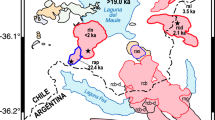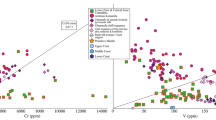Summary
Anorogenic granites are principally associated with alkaline ring complexes or anorthositic suites. Compositional relationships in the granites may be largely the result of variable compositions of fluid phases present during the initial melting and/or later evolution. For example, the negative K2O-SiO2 relationships in granites associated with alkaline rocks is consistent with: (1) evolution of the initial melts in a CO2-rich environment, which causes the product of incongruent melting of biotite to be a prominent component of the derived magmas; and/or (2) crystallization of the granites in a CO2-rich environment, which causes a residual liquid to be rich in biotite component. Limited evidence indicates that granites evolved in fluorine-rich environments are enriched in Na and may have negative relationships between Na2O and SiO2. Fluorine-rich environments may be more characteristic of the silicic rocks in rapakivi-granit e/anorthosite complexes than of granites in alkaline suites.
Zusammenfassung
Anorogene Granite sind prinzipiell mit alkalischen Ringkomplexen oder AnorthositSerien assoziiert. Die spezielle Zusammensetzung dieser Granite resultiert vermutlich hauptsächlich aus der variablen Zusammensetzung der während des initialen Schmelzprozesses und/oder späteren magmatischen Evolution vorhandenen fluiden Phase. Zum Beispiel geht die negative Korrelation zwischen K2O und SiO2 in Graniten, die mit alkalinen Gesteinen assoziiert sind, konform mit 1) der Entwicklung der Initialschmelze in einem CO2-reichen Milieu, wodurch das Produkt des inkongruenten Schmelzens von Biotit als Komponente im Magma dominiert, und/oder 2) der Kristallisation der Granite in einem CO2-reichen Milieu, das wiederum eine biotitreiche Residualschmelze hervorruft. Limitierte Hinweise deuten an, daß Granite, die in einem fluorreichen Milieuentstehen, an Na angereichert sind und eine negative Korrelation zwischen Na2O und SiO2 zeigen. Fluorreiches Milieu ist vermutlich für die sauren Gesteine innerhalb von Rapakivi-Granit/Anorthosit-Komplexen eher charakteristisch als für Granite in alkalischen Serien.
Similar content being viewed by others
References
Anderson JL (1983) Proterozoic anorogenic plutonism of North America. In:Medaris LG Jr, Byers CW Mickelson DM, Shanks WC (eds) Proterozoic Geology: selected papers from an international symposium. Geol Soc Am Memoir 161: 133–154
Bailey JC (1977) Fluorine in granitic rocks and melts: a review. Chem Geol 19: 1–42
Barker F, Wones DR, Sharp WN, Desborough GA (1975) The Pikes Peak batholith, Colorado Front Range, and a model for the origin of the gabbro-anorthosite-syenite-potassic granite suite. Precambrian Res 2: 97–160
Blaxland AB, van Breemen O, Emeleus CH, Anderson JG (1978) Age and origin of the major syenite centers in the Gardar province of South Greenland: Rb-Sr studies. Geol Soc Am Bull 89: 231–244
Bowden P (1985) The geochemistry and mineralization of alkaline ring complexes in Africa (a review). In:Black R, Bowden P (eds) Alkaline ring complexes in Africa. J African Earth Sci 3: 17–39
—Bennett JN, Whitley JE, Moyes AB (1979) Rare earths in Nigerian Mesozoic granites and related rocks. In:Ahrens LH (ed) Origin and distribution of the elements (Second symposium). Phys Chem Earth 11: 479–491
Brown WL, Moreau C, Demaiffe D (1989) An anorthosite suite in a ring-complex: crystallization and emplacement of an anorogenic type from Abontorok, Air, Niger. J Petrol 30: 1501–1540
Congdon RD, Nash WP (1991) Eruptive pegmatite magma: Rhyolite of the Honeycomb Hills, Utah. Am Mineral 76:1261–1278
Damman AH (1989) The fluid evolution of a high-level anorogenic granite from the Gasborn area, West Bergslagen, central Sweden. Lithos 22: 159–172
Dingwell DB (1988) The structure and properties of fluorine-rich magmas: a review of experimental studies. In:Taylor RP, Strong DF (eds) Recent advances in the geology of granite-related mineral deposits, spec vol 39. Canadian Inst Mining Metallurgy, Montreal, pp 1–12
DuBray EA (1988) Geology of the Silsilah ring complex and associated tin mineralization, Kingdom of Saudi Arabia. US Geol Surv Prof Pap 1459: 47 pp
Eby GN (1990) The A-type granitoids: a review of their occurrence and chemical characteristics and speculations on their petrogenesis. Lithos 26: 115–134
Haapala I (1977) Petrography and geochemistry of the Eurajoki stock, a rapakivi-granite complex with greisen-type mineralization in southwestern Finland. Geol Surv Finland Bull 286, 128pp
—Ramo OT (1990) Petrogenesis of the Proterozoic rapakivi granites of Finland. In:Stein HJ, Hannah JL (eds) Ore-bearing granite systems. Petrogenesis and mineralizing processes. Geol Soc Amer Spec Pap 246, pp 275–286
Hewitt DA, Wones DR (1984) Experimental phase relations of the micas. In:Bailey SW (ed) Micas. Min Soc Amer Reviews in Mineralogy 13, pp 201–257
Husch JM, Moreau C (1982) Geology and major element geochemistry of anorthositic rocks associated with Paleozoic hypabyssal ring complexes, Air massif, Niger, West Africa. J Volcanol Geotherm Res 14: 47–66
Jago BC, Gittins J (1991) The role of fluorine in carbonatite magma evolution. Nature 349: 56–58
Johannes W (1988) What controls partial melting in migmatites? J Metam Geol 6: 451–465
Kinnaird JA, Bowden P., Ixer RA, Odling NWA (1985) Mineralogy, geochemistry, and mineralization of Ririwai complex, northern Nigeria. In:Black R, Bowden P (eds) Alkaline ring complexes in Africa. J African Earth Sci 3: 185–222
Long LE, Sial AN, Nekvasil H, Borba GS (1986) Origin of granite at Cabo de Santo Agostinho, northeast Brazil. Contrib Mineral Petrol 92: 341–350
Luth RW (1988a) Effects of F on phase equilibria and liquid structure in the system NaAlSiO4-CaMgSi2O6-SiO2. Am Mineral 73:306–312
2 (1988b) Raman spectroscopic study of the solubility mechanisms of F in glasses in the system CaO-CaF2-SiO2. Am Mineral 73: 297–305
2Muncill GE (1989) Fluorine in alumino-silicate systems: phase relationships in the system NaAlSi3O8-CaAl2Si2O8-F2O−1. Geochim Cosmochim Acta 53:1937–1942
Jahns RH,Tuttle OF (1964) The granite system at pressures of 4 to 10 kilobars. J Geophys Res 69: 759–773
Macdonald R, Rock NMS, Rundle CC, Russell OJ (1986) Relationships between late Caledonian lamprophyric, syenitic, and granitic magmas in a differentiated dyke, southern Scotland. Mineral Mag 50: 547–557
Manning DAC (1981) The effect of fluorine on liquidus phase relationships in the system QZ-AB-OR with excess water at 1 kbar. Contrib Mineral Petrol 76: 206–215
Munoz JL (1984) F-OH and Cl-OH exchange in micas with applications to hydrothermal ore deposits In:Bailey SD (ed) Min Soc Am Reviews in Mineralogy 13: pp 469–493
Nabelek PI, Russ-Nabelek C (1990) The role of F in the petrogenesis of magmatic segregations in the St. Francois volcano-plutonic terrane, southeast Missouri. In:Stein HJ, Hannah JL (eds) Ore-bearing granite systems. Petrogenesis and mineralizing processes. Geol Soc Am Spec Pap 246, pp 71–87
Newton RC (1989) Metamorphic fluids in the deep crust. Ann Rev Earth Planet Sci 17: 385–412
Nurmi PA, Haapala I (1986) The Proterozoic granitoids of Finland: granite types, metallogeny, and relation to crustal evolution. Geol Soc Finland Bull 58: 203–233
Peterson JW (1989) Experimental investigation on the melting of biotite-quartz-feldspar assemblages and its potential role in granulite facies metamorphism. Thesi University of Chicago, Chicago, Illinois, USA
Newton RC (1989a) CO2-enhanced melting of biotite-bearing rocks at deep-crustal pressure-temperature conditions. Nature 340: 378–380
Newton RC (1989b) Reversed experiments on biotite-quartz-feldspar melting in the system KMASH: implications for crustal anatexis. J Geol 97: 465–485
2 (1990) Experimental biotite-quartz melting in the KMASH-CO2 system and the role of CO2 in the petrogenesis of granites and related rocks. Am Mineral 75: 1029–1042
2Chacko T, Kuehner SM (1991) The effects of fluorine on the vapor-absent melting of phlogopite + quartz: Implications for deep-crustal processes. Am Mineral 76: 470–476
Puziewicz J, Johannes W (1988) Phase equilibria and compositions of Fe-Mg-Al minerals and melts in water-saturated peraluminous granitic systems. Contrib Mineral Petrol 100: 156–168
Ramo OT (1991) Petrogenesis of the Proterozoic rapakivi granites and related basic rocks of southeastern Fennoscandia: Nd and Pb isotopic and general geochemical constraints. Geol Surv Finland Bull 355: 161 pp
Rogers JJW (1988) The Arsikere granite of southern India: magmatism and metamorphism in a previously depleted crust. Chem Geol 67: 155–163
Greenberg JK (1990) Late-orogenic, post-orogenic, and anorogenic granites: distinction by major-element and trace-element chemistry and possible origin. J Geol 98: 291–309
Ragland PC,Nishimori R, Greenberg JK, Hauck SH (1978) Varieties of granitic uranium deposits and favorable exploration areas in the eastern United States. Econ Geol 73: 1539–1555
Skjerlie KP, Johnston AD (1992) Vapor-absent melting at 10 kbar of a biotite- and amphibole-bearing tonalitic gneiss: implications for the generation of A-type granites. Geology 20: 263–266
Streckeisen A (1976) To each plutonic rock its proper name. Earth Sci Rev 12: 1–33
Upton BGJ, Emeleus CH (1987) Mid-Proterozoic alkaline magmatism in southern Greenland: the Gardar province. In:Fitton JG, Upton BGJ (eds) Alkaline igneous rocks. Geol Soc London Spec Pub 30, pp 449–471
Vorma A (1976) On the petrochemistry of rapakivi granites with special reference to Laitila massif, southwestern Finland. Geol Surv Finland Bull 285, 98pp
Whalen JB, Currie KL (1990) The Topsails igneous suite, western Newfoundland. Fractionation and magma mixing in an “orogenic” A-type granite suite. In:Stein HJ, Hannah JL (eds) Ore-bearing granite systems. Petrogenesis and mineralizing processes. Geol Soc Am Spec Pap 246, pp 287–299
Whitney JA (1988) The origin of granite: the role and source of water in the evolution of granitic magmas. Geol Soc Am Bull 100: 1886–1897
Author information
Authors and Affiliations
Rights and permissions
About this article
Cite this article
Rogers, J.J.W., Satterfield, M.E. Fluids of anorogenic granites: A preliminary assessment. Mineralogy and Petrology 50, 157–171 (1994). https://doi.org/10.1007/BF01160145
Received:
Accepted:
Issue Date:
DOI: https://doi.org/10.1007/BF01160145




